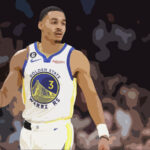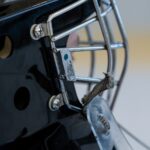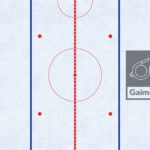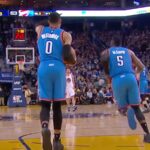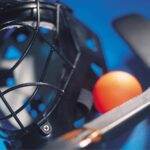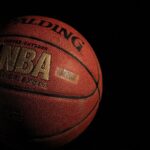When people search the term online for "Dek Hockey", it is grouped together with other sports such as street hockey, road hockey, floor hockey and ball hockey.
These sports terms are all used to describe the game of hockey played on foot, with the use of a ball rather than a puck (as in ice hockey). However, each of these terms have a different level of organization, surface used, rink dimensions to name a few.
For example, road hockey is simply ball hockey played on the street asphalt with your friends with no demarcated playing area.
Street hockey can be described as the exact same thing, except that there are official street hockey tournaments that are organized with established playing areas surrounded by boards.
Floor hockey is typically played on a wooden or hard surface, found in a gymnasium.
Finally, ball hockey is played in a rink on the concrete layer. You’ll see many organized ball hockey leagues play on the melted-down surface of an ice rink.
In the end, each of these hockey variations have their own unique characteristics, and Dek Hockey is no exception.
What is Dek Hockey?
Dek Hockey is a variation of Ball Hockey, played on a surface called sport court. Players play on foot with an orange ball and a boarded rink. Dek hockey rinks are typically distinguishable by the blue color of the sport court tiles. The surface reduces lateral and vertical stresses, better protecting players from common leg and foot injuries.
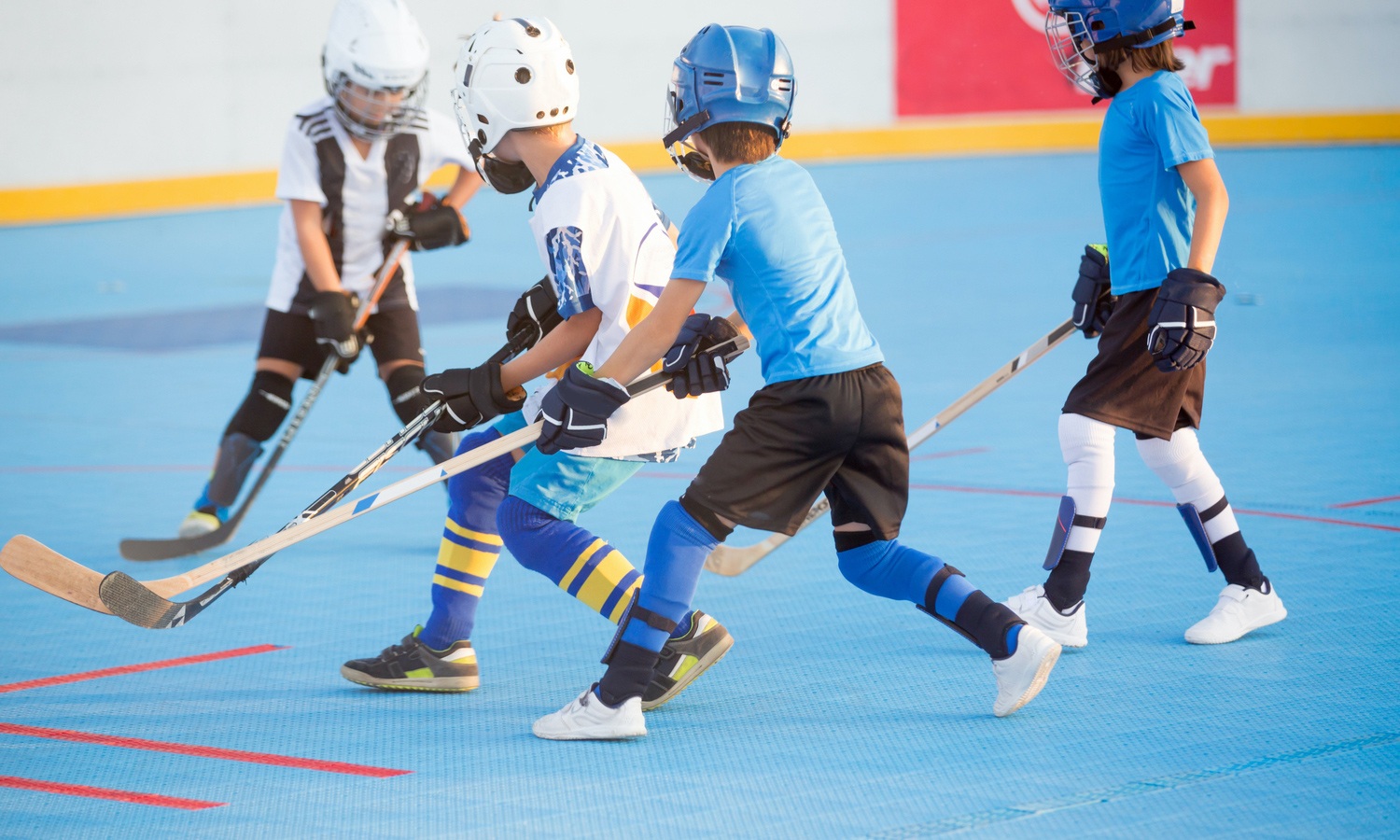
Since the dimensions of a Dek Hockey Rink are typically smaller in size compared to Ball Hockey Rinks, teams usually compete at 3x3 or 4x4 (excluding the goalie). See the various Dek Hockey rink sizes and comparison to Ball Hockey rinks below.
It should be noted that Dek Hockey leagues do offer 5x5 game play as well, which was actually the standard when Raymond W. Leclerc, founder of Mylec, first introduced the dek surface back in 1974.
The first Dek Hockey rinks were developed at the Leominster DekHockey Centre in Leominster, Massachusetts. Leclerc built 3 outdoor rinks at the time (source).
Since then, you can find many Dek Hockey rinks throughout the USA and Canada. In fact, many facilities offer indoor Dek Hockey rinks to allow for play during the winter months.
What do Dek Hockey tiles look like?
Sport Court tiles, used for Dek Hockey, have a mesh-like pattern made of perforated plastic. Depending on the manufacturer, the center lines and the faceoff dots can either be painted on or represented by different color tiles. And, as stated before, the main tiles are usually blue in color.
The tiles allow for better traction, less stress on the feet and when installed outdoors, rain can easily drain through the mesh to the space below.
Although the following "How It's Made" video by Versacourt describes the production of basketball sport court tiles, the same company produces dek surfaces for hockey as well.
The reason why the sport court tiles are referred to as a "dek" surface is because of the transition of the sport from street hockey onto these specialized surfaces both for indoor and outdoor rinks. The players would state playing ball hockey on "the dek".
Dek Hockey Rink Dimensions
The original Dek Rink dimensions were a minimum of 160x80ft (LxW) in size to accommodate for 5x5 play.
But today, you’ll find rinks of various sizes including:

Image: The 2x Dek Hockey rinks at DekHockey St-Eustache, Québec are both 120x60 ft in size.
The rinks 160x80 ft or larger will include both the center line and blue lines. The smaller rinks for 3x3 and 4x4 play will only have a center line.
Some leagues may not even use the center line for offsides, while others do. In fact, when it comes to the Dek 5x5 rinks, the center line is the only line used to determine offsides.
As for ball hockey rinks, typically they are of equal size to ice hockey rinks:
That’s because many ball hockey leagues play on the concrete layer found below the ice.
When it comes to Ball Hockey, the blue line is used to initially determine offsides. Once in the offensive zone, players can move the ball as far back as the center line, known as the floating blue line rule.
Equipment used for Dek Hockey
Player Equipment
At minimum, running shoes, ice hockey or dek hockey gloves, shin guards, helmet with chin strap and hockey stick (no tape under stick palette), team jersey.
Visiting team must wear a different color jersey if both teams have the same team color.
Ball
Mylec and D-Gel brand balls are standard used balls. Some of today’s balls have a hard outer -layer for better stickhandling and are liquid-injected to mitigate the bounce.
See the types of balls in this section of the blog post.
Nets
6x4 ft net size, 27-inch depth at the base and 18-inch depth at the crossbar level.
Sticks
For the most part, any ice hockey sticks will do, including the popular composite sticks. The only caveat, as mentioned earlier, is that the stick blade cannot be taped underneath. So, rather than taping the blade in loops as you would for ice hockey, you would add tape strips parallel to the blade.
History of Dek Hockey
As mentioned earlier, Dek Hockey was first played in Leominster, Massachusetts back in 1974. Raymond W. Leclerc, founder of Mylec Corp, developed the first 3 outdoor dek hockey surfaces in Leominster. The facility is known as the Leominster DekHockey Centre.
In addition to building the first ever dek rinks, Leclerc was also responsible for creating the No Bounce orange ball, used for both ball hockey and dek hockey leagues.
This ball was originally used for the game, but there was one major problem with it. The ball was very malleable and was very hard to stickhandle.
His company went on to create the G-Force hard ball with liquid-injection. The ball offers better control for stickhandling all while maintaining minimal bounce.
There are 4 versions of the G-Force ball to compensate for the various weather conditions:
At room temperature, each ball will feel harder than the next, from Yellow to Red.
Final Thoughts
As an avid ice hockey player, myself, I was surprised to learn how many Dek Hockey rinks exist. This is especially true in my home town of Montreal, Quebec in Canada.
There are many other cities throughout the province that house multiple Dek Hockey rinks because of the high demand for youth and adult game play.
Currently, there isn’t an official list online for all these facilities. Just by doing a quick search, I’ve tracked down over 20 facilities in Quebec alone.
Furthermore, there is a DekHockey Provincial Tournament that takes place annually during the summer time in Quebec. It is known as the “Championnat Provincial HockeyQC”, which translates to the HockeyQC Provincial Championship exclusively for the Dek Hockey game.
The Summer 2020 Championnat Provincial HockeyQC tournament featured social distancing rules because of COVID-19.
I’m also aware of the National Dekhockey Association 3 on 3, home to the Quad City, Waterloo and Springfield DekHockey rinks in Iowa. They describe themselves as the biggest league of 3 vs. 3 Dekhockey in the United States.
See the 2019 NDA National Tournament Open Final Highlights here:
If you know of any other major tournaments, whether North American or worldwide, exclusively for Dek Hockey, leave a comment below.
Lastly, keep in mind that the Dek Hockey surfaces can be used to play inline or roller hockey.
